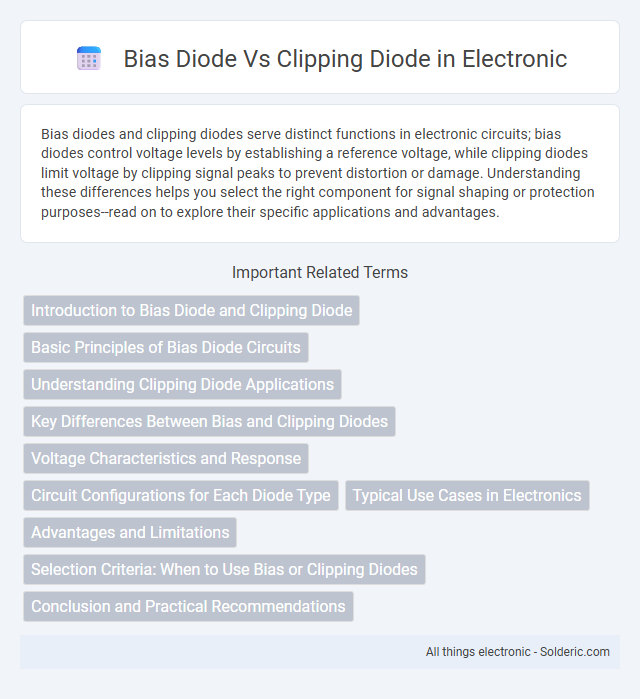Bias diodes and clipping diodes serve distinct functions in electronic circuits; bias diodes control voltage levels by establishing a reference voltage, while clipping diodes limit voltage by clipping signal peaks to prevent distortion or damage. Understanding these differences helps you select the right component for signal shaping or protection purposes--read on to explore their specific applications and advantages.
Comparison Table
| Feature | Bias Diode | Clipping Diode |
|---|---|---|
| Primary Function | Controls bias voltage in circuits | Limits voltage to prevent signal exceeding set level |
| Operation | Maintains constant DC voltage via forward/reverse bias | Clips peaks of AC signals by conducting at threshold voltage |
| Common Applications | Biasing transistors, amplifiers | Wave shaping, signal protection, noise reduction |
| Voltage Behavior | Sets fixed voltage level for device operation | Restricts voltage amplitude beyond clipping threshold |
| Circuit Position | Typically in biasing networks with resistors | Placed across signal lines or load for clipping action |
| Effect on Signal | No signal distortion; stabilizes DC operating point | Distorts waveform by cutting voltage peaks |
| Key Component Types | Standard PN junction or Zener diodes | Zener, Schottky, or silicon diodes optimized for clipping |
Introduction to Bias Diode and Clipping Diode
A bias diode is a semiconductor device designed to control current flow in circuits by applying a specific voltage bias, influencing its conductive state. A clipping diode is used primarily to limit voltage levels by "clipping" signals that exceed predefined thresholds, protecting components from voltage spikes. Both diodes serve distinct roles in shaping and regulating electrical signals within electronic systems.
Basic Principles of Bias Diode Circuits
Bias diode circuits utilize forward or reverse biasing to control current flow, enabling precise voltage regulation and signal conditioning in electronic devices. Clipping diodes, however, are specifically designed to limit voltage levels by clipping signals beyond predefined thresholds, protecting circuits from voltage spikes. Understanding these basic principles helps you select the appropriate diode configuration for stable and efficient circuit performance.
Understanding Clipping Diode Applications
Clipping diodes are used to prevent voltage levels from exceeding a specified threshold, protecting circuits by effectively "clipping" the signal waveform. Unlike bias diodes, which primarily influence current flow by setting a voltage reference point, clipping diodes limit voltage peaks, making them essential in signal conditioning and voltage regulation applications. Your circuits benefit from clipping diodes by avoiding damage from voltage spikes and ensuring stable signal processing.
Key Differences Between Bias and Clipping Diodes
Bias diodes control the operating point of an electronic circuit by maintaining a constant voltage, while clipping diodes restrict signal voltage to prevent it from exceeding predefined limits, shaping the waveform. The key difference lies in their function; bias diodes manage circuit biasing to ensure stable operation, whereas clipping diodes protect circuits by limiting voltage peaks. Understanding these distinctions helps you select the appropriate diode for signal processing or circuit stabilization tasks.
Voltage Characteristics and Response
Bias diodes maintain a constant voltage drop, typically around 0.7V for silicon, allowing signals above this threshold to pass while blocking lower voltages, which stabilizes voltage levels in circuits. Clipping diodes, however, sharply limit voltage amplitude by clipping signals that exceed a predefined threshold, preventing voltage spikes and protecting downstream components. The response of bias diodes is gradual due to their forward voltage drop, whereas clipping diodes exhibit an abrupt voltage limiting action, crucial for signal shaping and protection.
Circuit Configurations for Each Diode Type
Bias diode circuits typically utilize forward-bias configurations to regulate voltage levels and control signal flow by allowing current to pass when a specific threshold is met. Clipping diode circuits are arranged in parallel with the load to clamp voltage peaks, preventing signal excursions beyond set voltage limits and protecting sensitive components. Understanding these circuit configurations helps you select the appropriate diode type for voltage regulation or waveform shaping in your electronic design.
Typical Use Cases in Electronics
Bias diodes are commonly used in voltage regulation and signal biasing circuits to maintain a stable operating point for transistors and other semiconductor devices. Clipping diodes serve a crucial role in protecting circuits by limiting voltage levels and shaping signal waveforms, preventing distortion or damage in audio, RF, and power electronics applications. Both types of diodes enhance circuit performance, with bias diodes optimizing linear operation and clipping diodes ensuring voltage thresholds are respected.
Advantages and Limitations
Bias diodes offer improved signal control by maintaining a consistent voltage threshold, enhancing circuit stability and reducing distortion, making them ideal for precision applications. Clipping diodes provide effective voltage limiting to protect circuits from voltage spikes but may introduce signal clipping that can cause distortion in audio or sensitive analog signals. Your choice depends on whether you need stable signal regulation or simple surge protection, balancing precision against potential signal alteration.
Selection Criteria: When to Use Bias or Clipping Diodes
Selection criteria for bias diodes versus clipping diodes depend on the desired signal control. Use bias diodes when precise voltage regulation or stabilization is needed, as they maintain consistent voltage levels by allowing current flow under specific voltage conditions. Clipping diodes are preferred in protecting circuits by limiting voltage peaks and preventing signal distortion, ideal for safeguarding components from voltage spikes in your electronic designs.
Conclusion and Practical Recommendations
Bias diodes provide precise control over signal levels by adjusting forward voltage thresholds, making them ideal for amplification and signal conditioning applications. Clipping diodes protect circuits by limiting voltage peaks, preventing damage from transient spikes or overloads, suited for waveform shaping and voltage regulation. Selecting between bias and clipping diodes depends on whether the requirement prioritizes signal modulation accuracy or overvoltage protection in the circuit design.
Bias diode vs Clipping diode Infographic

 solderic.com
solderic.com